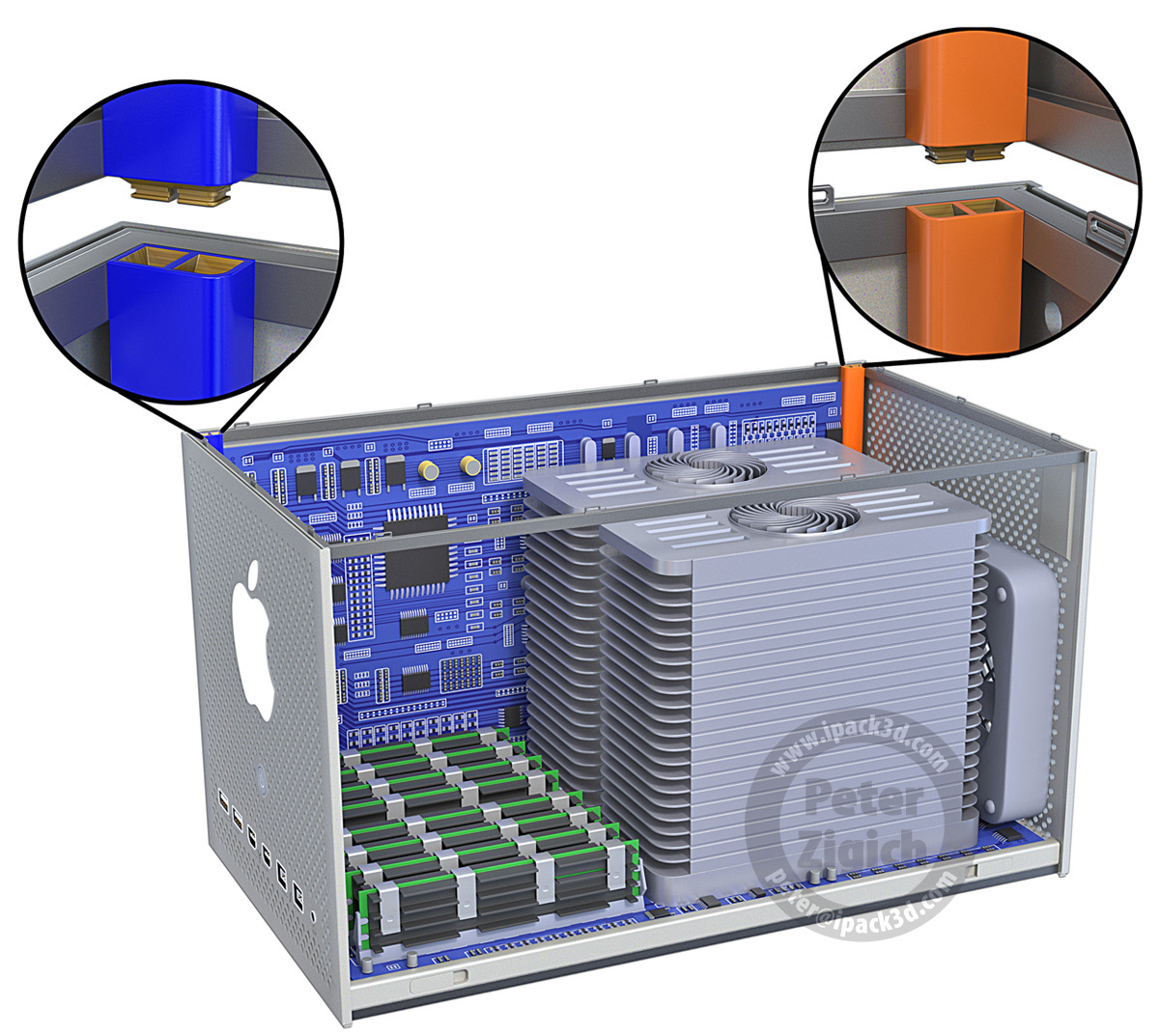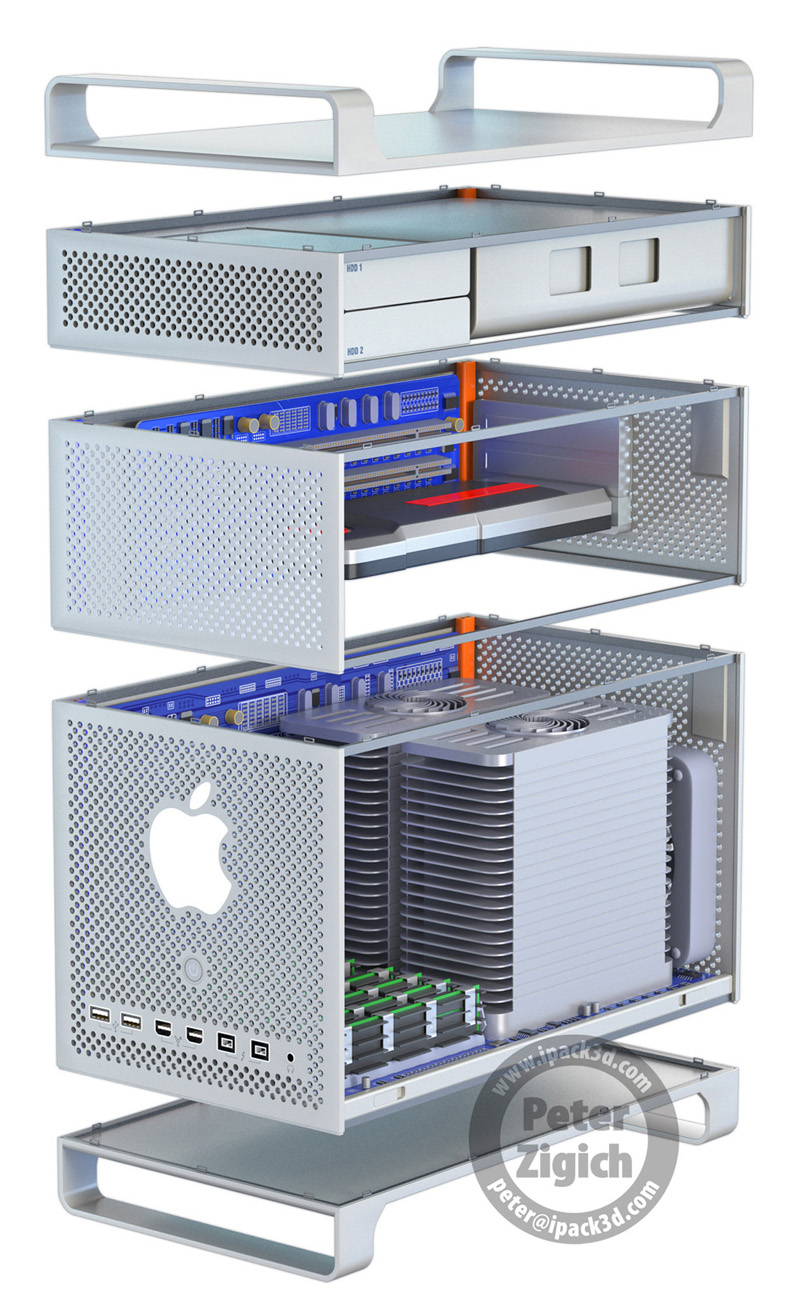My question: is this even possible? It doesn't seem like TB would provide enough bandwidth.
It is possible. It largely depends upon how to slice up the old Mac Pro. The current Mac Pro has 3 major thermal zones and a few sub areas within those zones. There are the top "5.25 bay + power supply" , " 3.5" sleds + PCI-e card zone" , and "CPU zone".
http://en.wikipedia.org/wiki/File:Side_Power_Mac_G5_-_Mac_Pro_.jpeg
[ Mac Pro on Right, but G5 has similar philosophy. From Mac Pro wikipedia page.
http://en.wikipedia.org/wiki/Mac_Pro. I'd use a cleaner Apple image but it will probably change (or break) over time.) ]
Let's ignore where the Power Supply will go and start chopping them off.
1. Chop off 5.25 bays and send to outside box. Requires external SATA controller in outside box but well within TB's abilities.
2. Chop off 3.5 drive sleds. ( there are several 4 bay external drive devices already on the market). Again well within ablities and could create a single box that consumes both of these slices.
3. Not so apparent in picture is front facing USB and FW sockets. Again chop these off and send to external box. Need to put additional USB and FW controllers in external box but well within TB's range.
So far have lopped off probably around 1/4 or so of the box.
4. Chop off two x4 PCI-e slots. Well frankly that might be were getting the x4 for TB controller so that's gone anyway. [ In most deployed TB designs so far the controller snags x4 lanes off the IOHub/Southbridge controller which has x8 to spread around. ]. In the current Mac Pro those two x4 are switched so really only have x4 worth of bandwidth there.
If go into hocus-pocus multiple TB controller design mode can make up how these are farmed off to 2nd controller since really are getting to state of dilution at this point if also shuffling this slots to an external PCI-e cage on the same TB network.
At this point have looped off probably over 1/3 or so of the box.
All of that is pretty feasible. It substantively increases total system cost to "reassemble" it but it could be done even if it doesn't make economic sense.
It wastes a small amount of money internally because the SATA controller have to buy for the CPU anyway has support for 6+ devices and now have none. Sure can slip in a single boot drive , but still wasting vast majority of SATA channels already paid for.
Is net overall completed system space or weight going down? Nope. All the external boxes require more power supplies. TB is not a modular power supply solution. Never was intended to be a major modular power supply solution.
Also each one of these external boxes has to take on the overhead of handling the "backward compatible with Display Port" that these subsystems don't need if kept inside an integrated box where DP has a dedicated separate path already.
Where the ultimate modularity design take a right turn into the swamp is where they start chopping off the components lower down on the current Mac Pro.
5. Start chopping off x16 slots and moving them outside. Well that means giving up x12 worth of bandwidth. All modern Intel options are PCI-e v3.0 and Thunderbolt is stuck at v2.0. So dropping a single x16 v3.0 is equivalent of dropping x32 worth of v2.0 bandwidth. So sure toss x28 lanes of PCI-e down the drain to go external.
Surprisingly pragmatically this will work for a fairly large number of folks. There are GPU workloads ( games , mainstream apps ) that are optimized for x8 worth of bandwidth. So dropping down to x4 doesn't as much as a killer as it would appear. The compression, caching, and coping workaround the apps have installed triage the loss of bandwidth to that it won't have as much of a dramatic drop of.
However can't chop off too many x16 connections because where are you going to get the Display Port output streams from????? And will the user really want to hook their display into this "smaller for smaller sake" network?
6. Start chopping off the interconnections between CPU packages and/or RAM. This gets to deep into the swamp. Here are the speeds that Intel and AMD use for CPU interconnect.
QPI (7.2GT/s Intel) 230 Gb/s
QPI (8GT/s Intel ) 256 Gb/s
HyperTransport 3.0 (AMD) 332 Gb/s
HyperTransport 3.1 (AMD) 409 Gb/s
In a dual Xeon E5 2600 set up the CPU packages are interconnected with
two QPI links so double those Intel numbers above.
This is an order of magnitude off from even the "new and improved" TB v2.0 (20Gb/s as long as you not transport any video) that is a year away from now. That is just bandwidth. The latency overhead is off by a mile also.
The notion that TB is going to get you a unified system image cluster running at similar speeds is not going to happen at all. Not even close.
What folks used for cluster interconnect is in a whole another ball game. For example Intel's (former Cray's) Aries interconnect switch requires a full x16 PCIe
v3.0 connection to the CPU and much higher than that between the switches.
http://www.theregister.co.uk/2012/11/08/cray_cascade_xc30_supercomputer/ Thunderbolt would be a cruel joke as a replacement.





